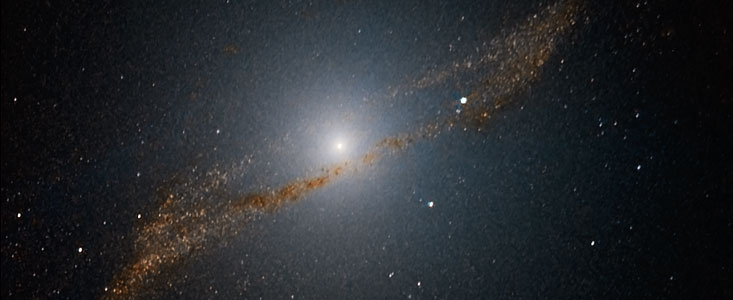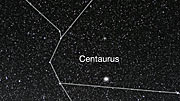Persbericht
Nieuwe techniek toont hoe kannibaalsterrenstelsel ‘dineert’
20 november 2009
Een nieuwe techniek, waarbij gebruik wordt gemaakt van nabij-infrarood opnamen van ESO’s 3,58-meter New Technology Telescoop (NTT), stelt astronomen in staat om door de ondoorzichtige stofbanen te kijken van het reusachtige kannibaalsterrenstelsel Centaurus A, waarbij zijn ‘laatste maaltijd’ - een kleiner spiraalstelsel - in ongekend detail wordt onthuld. Deze verbazingwekkende foto toont ook duizenden sterclusters die, uitgestrooid als schitterende juwelen, heftig bewegen binnen Centaurus A.
Centaurus A (NGC 5128) is een gigantisch ellipsvormig sterrenstelsel, relatief nabijgelegen op een afstand van ongeveer 11 miljoen lichtjaar. Het is een van de meest bestudeerde objecten aan de zuidelijke hemel. In 1847 trok het unieke uiterlijk van dit sterrenstelsel al de aandacht van de beroemde Britse astronoom John Herschel, die een catalogus van de zuidelijke sterrenhemel maakte en een uitgebreide lijst van nevels samenstelde.
Herschel kon echter niet weten dat deze prachtige en spectaculaire verschijning te danken was aan een ondoorzichtige stofstrook die het centrale gedeelte van het sterrenstelsel bedekte. Men denkt dat dit stof het restant is van een kosmische fusie tussen een reusachtig elliptische sterrenstelsel en een kleiner spiraalstelsel vol stof.
Tussen 200 en 700 miljoen jaar geleden heeft dit sterrenstelsel waarschijnlijk een kleiner spiraalvormig, gasrijk sterrenstelsel in zich opgenomen, dat nu nog rondtolt in de kern van Centaurus A en daar nieuwe generaties sterren voortbrengt.
Eerste indrukken van de 'restjes van deze maaltijd’ werden verkregen dankzij de waarnemingen met de ESA-Infrared Space Observatory , die een 16500 lichtjaar grote structuur onthulde, vergelijkbaar met die van een klein sterrenstelsel. Daarna heeft NASA's Spitzer Space Telescope deze structuur herleid tot een parallellogram, dat verklaard kan worden als het restant van een gasrijk spiraalstelsel dat opgaat in een ellipsvormig sterrenstelsel en tijdens dit proces wordt gedraaid en kromgetrokken. Botsende sterrenstelsels zijn de meest voorkomende verklaringen voor de vorming van zulke reusachtige elliptische sterrenstelsels.
Met de nieuwe SOFI beelden van ESO’s 3,58-meter New Technology Telescope op La Silla, kunnen astronomen een nog scherper beeld krijgen van de structuur van dit sterrenstelsel, geheel vrij van verduisterend stof. De originele beelden in het nabij-infrarood met drie verschillende filters (J, H, K), werden gecombineerd met een nieuwe techniek die het verduisterende effect van het stof opheft, en een duidelijk beeld geeft van het centrum van dit sterrenstelsel.
Wat de astronomen vonden was verbazingwekkend: “Er is een heldere ring van sterren en clusters verscholen achter de stofbanen en onze beelden laten een ongekend gedetailleerde blik zien”, zegt Jouni Kainulainen, eerste auteur van de paper waarin de resultaten worden beschreven. “Verdere analyse van deze structuur zal ons belangrijke aanwijzingen geven over hoe het fuseren plaatsvond en welke rol stervorming hierbij heeft gespeeld.”
Het onderzoeksteam is zeer enthousiast over de mogelijkheden van deze nieuwe techniek: “Dit zijn de eerste stappen in de ontwikkeling van een techniek die de potentie heeft om gigantische gaswolken in andere sterrenstelsels te traceren met hoge resolutie en op een rendabele manier”, legt co-auteur João Alves uit. “Weten hoe deze gigantische wolken zich vormen en ontwikkelen betekent begrijpen hoe sterren ontstaan in sterrenstelsels.”
Vooruitkijkend naar toekomstige telescopen, zowel op aarde als in de ruimte: “deze techniek is heel aanvullend naast de radiogegevens die ALMA zal verzamelen van nabijgelegen sterrenstelsels en tegelijkertijd geeft deze techniek interessante onderzoeksmogelijkheden voor extragalactische sterpopulaties met de toekomstige European Extremely Large Telescope and the James Webb Space Telescope, omdat stof alomtegenwoordig is in het heelal”, zegt co-auteur Yuri Beletsky.
Eerdere waarnemingen met ISAAC op de VLT hebben onthuld dat zich een superzwaar zwart gat schuilhoudt in Centaurus A. Zijn massa is ongeveer 200 miljoen zonsmassa’s, ofwel 50 maal de massa van het zwarte gat dat zich in het centrum van onze Melkweg bevindt. In tegenstelling tot ons eigen sterrenstelsel wordt het superzware zwarte gat in Centaurus A voortdurend gevoed door materiaal, waardoor dit reuzenstelsel een heel actief stelsel is. Centaurus A is een van de helderste radiobronnen aan de hemel (daarom de ‘A’ in zijn naam). Jets van hoogenergetische deeltjes vanuit het centrum zijn ook waargenomen in radio- en röntgenbeelden.
Deze nieuwe foto van Centaurus A is een schitterend voorbeeld van hoe grensverleggende wetenschap gecombineerd kan worden met esthetische aspecten. Mooie beelden van Centaurus A zijn in het verleden verkregen met ESO’s Very Large Telescope (ESO PR Photo 05b/00) en met de Wide Field Imager van de MPG/ESO 2,2-meter telescoop op La Silla.
Meer informatie
Dit onderzoek is gepresenteerd in een paper in Astronomy and Astrophysics (vol. 502): “Uncovering the kiloparsec-scale stellar ring of NGC5128”, by J.T. Kainulainen et al.
Het team bestaat uit J. T. Kainulainen (University of Helsinki, Finland, and MPIA, Duitsland), J. F. Alves (Calar Alto Observatory, Spanje en University of Vienna, Oostenrijk), Y. Beletsky (ESO), J. Ascenso (Harvard-Smithsonian Center for Astrophysics, USA), J. M. Kainulainen (TKK/Department of Radio Science and Engineering, Finland), A. Amorim, J. Lima, and F. D. Santos (SIM-IDL, University of Lisbon, Portugal), A. Moitinho (SIM-IDL, University of Lisbon, Portugal), R. Marques and J. Pinhão (University of Coimbra, Portugal), and J. Rebordão (INETI, Amadora, Portugal).
ESO, de Europese Zuidelijke Sterrenwacht, is de belangrijkste intergouvernementele sterrenkundeorganisatie in Europa en wereldwijd het meest productieve astronomische observatorium. ESO wordt ondersteund door 14 landen: België, Denemarken, Duitsland, Finland, Frankrijk, Italië, Nederland, Oostenrijk, Portugal, Spanje, Tsjechië, het Verenigd Koninkrijk, Zweden en Zwitserland. ESO voert een ambitieus programma uit gericht op het ontwerp, de bouw en de exploitatie van krachtige grondobservatoria die astronomen in staat stellen om belangrijke wetenschappelijke ontdekkingen te doen. ESO speelt ook een leidende rol in het bevorderen en organiseren van samenwerking in het sterrenkundig onderzoek. ESO exploiteert drie observatielocaties van wereldklasse in Chili: La Silla, Paranal en Chajnantor. Op Paranal exploiteert ESO de Very Large Telescope (VLT), 's werelds meest geavanceerde optische observatorium en ESO is de Europese partner van de revolutionaire telescoop ALMA. ESO is momenteel bezig met ontwerpstudies voor de 42-meter Europese Extremely Large optische/nabij-infrarood Telescoop ( E-ELT), die ‘het grootste oog op de hemel’ ter wereld zal worden.
Links
Contact
Jouni Kainulainen
MPIA
Germany
Tel: +49-6221-528427
E-mail: jtkainul@mpia-hd.mpg.de
Yuri Beletsky
ESO
Chile
Tel: +56 55 43 5311
E-mail: ybialets@eso.org
João Alves
Calar Alto Observatory
Spain
Tel: +34 950 632 501
E-mail: jalves@caha.es
Marieke Baan (Perscontact Nederland)
ESO Science Outreach Network
en NOVA Informatie Centrum
Tel: +31(0)20-5257480
E-mail: eson-netherlands@eso.org
Over dit bericht
| Persberichten nr.: | eso0944nl |
| Legacy ID: | PR 44/09 |
| Naam: | Centaurus A, NGC 5128 |
| Type: | Local Universe : Galaxy : Type : Elliptical Local Universe : Galaxy : Component : Central Black Hole |
| Facility: | New Technology Telescope, Very Large Telescope |
| Instruments: | NACO, SOFI |
| Science data: | 2009A&A...502L...5K |
Our use of Cookies
We use cookies that are essential for accessing our websites and using our services. We also use cookies to analyse, measure and improve our websites’ performance, to enable content sharing via social media and to display media content hosted on third-party platforms.
ESO Cookies Policy
The European Organisation for Astronomical Research in the Southern Hemisphere (ESO) is the pre-eminent intergovernmental science and technology organisation in astronomy. It carries out an ambitious programme focused on the design, construction and operation of powerful ground-based observing facilities for astronomy.
This Cookies Policy is intended to provide clarity by outlining the cookies used on the ESO public websites, their functions, the options you have for controlling them, and the ways you can contact us for additional details.
What are cookies?
Cookies are small pieces of data stored on your device by websites you visit. They serve various purposes, such as remembering login credentials and preferences and enhance your browsing experience.
Categories of cookies we use
Essential cookies (always active): These cookies are strictly necessary for the proper functioning of our website. Without these cookies, the website cannot operate correctly, and certain services, such as logging in or accessing secure areas, may not be available; because they are essential for the website’s operation, they cannot be disabled.
Functional Cookies: These cookies enhance your browsing experience by enabling additional features and personalization, such as remembering your preferences and settings. While not strictly necessary for the website to function, they improve usability and convenience; these cookies are only placed if you provide your consent.
Analytics cookies: These cookies collect information about how visitors interact with our website, such as which pages are visited most often and how users navigate the site. This data helps us improve website performance, optimize content, and enhance the user experience; these cookies are only placed if you provide your consent. We use the following analytics cookies.
Matomo Cookies:
This website uses Matomo (formerly Piwik), an open source software which enables the statistical analysis of website visits. Matomo uses cookies (text files) which are saved on your computer and which allow us to analyze how you use our website. The website user information generated by the cookies will only be saved on the servers of our IT Department. We use this information to analyze www.eso.org visits and to prepare reports on website activities. These data will not be disclosed to third parties.
On behalf of ESO, Matomo will use this information for the purpose of evaluating your use of the website, compiling reports on website activity and providing other services relating to website activity and internet usage.
Matomo cookies settings:
Additional Third-party cookies on ESO websites: some of our pages display content from external providers, e.g. YouTube.
Such third-party services are outside of ESO control and may, at any time, change their terms of service, use of cookies, etc.
YouTube: Some videos on the ESO website are embedded from ESO’s official YouTube channel. We have enabled YouTube’s privacy-enhanced mode, meaning that no cookies are set unless the user actively clicks on the video to play it. Additionally, in this mode, YouTube does not store any personally identifiable cookie data for embedded video playbacks. For more details, please refer to YouTube’s embedding videos information page.
Cookies can also be classified based on the following elements.
Regarding the domain, there are:
- First-party cookies, set by the website you are currently visiting. They are stored by the same domain that you are browsing and are used to enhance your experience on that site;
- Third-party cookies, set by a domain other than the one you are currently visiting.
As for their duration, cookies can be:
- Browser-session cookies, which are deleted when the user closes the browser;
- Stored cookies, which stay on the user's device for a predetermined period of time.
How to manage cookies
Cookie settings: You can modify your cookie choices for the ESO webpages at any time by clicking on the link Cookie settings at the bottom of any page.
In your browser: If you wish to delete cookies or instruct your browser to delete or block cookies by default, please visit the help pages of your browser:
Please be aware that if you delete or decline cookies, certain functionalities of our website may be not be available and your browsing experience may be affected.
You can set most browsers to prevent any cookies being placed on your device, but you may then have to manually adjust some preferences every time you visit a site/page. And some services and functionalities may not work properly at all (e.g. profile logging-in, shop check out).
Updates to the ESO Cookies Policy
The ESO Cookies Policy may be subject to future updates, which will be made available on this page.
Additional information
For any queries related to cookies, please contact: pdprATesoDOTorg.
As ESO public webpages are managed by our Department of Communication, your questions will be dealt with the support of the said Department.




